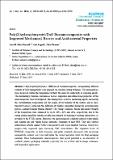Por favor, use este identificador para citar o enlazar a este item:
http://hdl.handle.net/10261/101046COMPARTIR / EXPORTAR:
 SHARE SHARE
 CORE
BASE CORE
BASE
|
|
| Visualizar otros formatos: MARC | Dublin Core | RDF | ORE | MODS | METS | DIDL | DATACITE | |

| Título: | Poly(3-hydroxybutyrate)/ZnO bionanocomposites with improved mechanical, barrier and antibacterial properties |
Autor: | Díez-Pascual, Ana M. CSIC ORCID; Díez-Vicente, Angel L. | Fecha de publicación: | 2014 | Editor: | Multidisciplinary Digital Publishing Institute | Citación: | International Journal of Molecular Sciences 15: 10950- 10973 (2014) | Resumen: | Poly(3-hydroxybutyrate) (PHB)-based bionanocomposites incorporating different contents of ZnO nanoparticles were prepared via solution casting technique. The nanoparticles were dispersed within the biopolymer without the need for surfactants or coupling agents. The morphology, thermal, mechanical, barrier, migration and antibacterial properties of the nanocomposites were investigated. The nanoparticles acted as nucleating agents, increasing the crystallization temperature and the degree of crystallinity of the matrix, and as mass transport barriers, hindering the diffusion of volatiles generated during the decomposition process, leading to higher thermal stability. The Young's modulus, tensile and impact strength of the biopolymer were enhanced by up to 43%, 32% and 26%, respectively, due to the strong matrix-nanofiller interfacial adhesion attained via hydrogen bonding interactions, as revealed by the FT-IR spectra. Moreover, the nanocomposites exhibited reduced water uptake and superior gas and vapour barrier properties compared to neat PHB. They also showed antibacterial activity against both Gram-positive and Gram-negative bacteria, which was progressively improved upon increasing ZnO concentration. The migration levels of PHB/ZnO composites in both non-polar and polar simulants decreased with increasing nanoparticle content, and were well below the current legislative limits for food packaging materials. These biodegradable nanocomposites show great potential as an alternative to synthetic plastic packaging materials especially for use in food and beverage containers and disposable applications | URI: | http://hdl.handle.net/10261/101046 | DOI: | 10.3390/ijms150610950 | Identificadores: | doi: 10.3390/ijms150610950 issn: 1422-0067 e-issn: 1422-0067 |
| Aparece en las colecciones: | (ICTP) Artículos |
Ficheros en este ítem:
| Fichero | Descripción | Tamaño | Formato | |
|---|---|---|---|---|
| Int. J. Mol. Sci. 2014.pdf | 1,77 MB | Adobe PDF |  Visualizar/Abrir |
CORE Recommender
PubMed Central
Citations
39
checked on 07-mar-2024
SCOPUSTM
Citations
214
checked on 13-abr-2024
WEB OF SCIENCETM
Citations
172
checked on 23-feb-2024
Page view(s)
343
checked on 18-abr-2024
Download(s)
257
checked on 18-abr-2024
Google ScholarTM
Check
Altmetric
Altmetric
Artículos relacionados:
NOTA: Los ítems de Digital.CSIC están protegidos por copyright, con todos los derechos reservados, a menos que se indique lo contrario.
